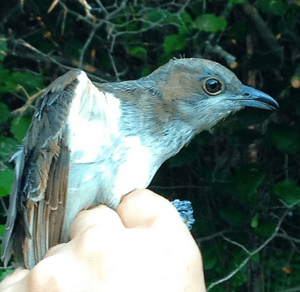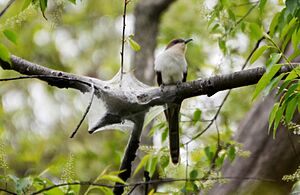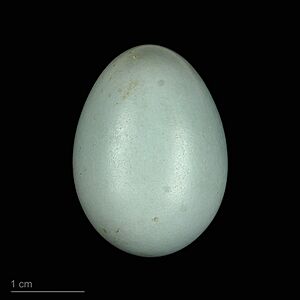Black-billed cuckoo facts for kids
Quick facts for kids Black-billed cuckoo |
|
|---|---|
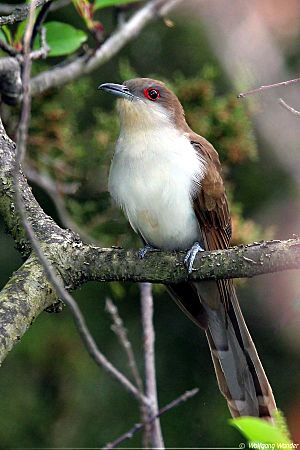 |
|
| Conservation status | |
| Scientific classification | |
| Genus: |
Coccyzus
|
| Species: |
erythropthalmus
|
The black-billed cuckoo (Coccyzus erythropthalmus) is a cool bird found in the New World, which means North and South America. It belongs to the Cuculidae family, also known as the cuckoo family. Its scientific name comes from Ancient Greek. Kokkuzo means "to call like a cuckoo," and erythropthalmus means "red eye."
This cuckoo looks a lot like its cousin, the yellow-billed cuckoo. They even live in some of the same places! Cuckoos are famous for laying their eggs in other birds' nests. This is called "brood parasitism." But the black-billed cuckoo often builds its own nest and raises its own chicks.
Contents
About the Black-billed Cuckoo
Adult black-billed cuckoos have a long, brown tail that looks like it's made of layers. They have a black beak that curves down a little. Their head and back are brown, and their belly is white. Their feet are special because two toes point forward and two point backward, which helps them grip branches.
Young cuckoos are not as brightly colored. They might have some reddish-brown feathers on their wings. Adult cuckoos have a thin red ring around their eyes. Young cuckoos have a yellow ring instead. Baby black-billed cuckoos have black skin with sparse white, tube-like feathers. They also have unique, creamy bumps on their mouth and tongue. These are normal for the species, not warts or infections!
Where Black-billed Cuckoos Live
Black-billed cuckoos can be found in many different places. They often live at the edges of grown-up deciduous forests (trees that lose their leaves) or mixed forests. You might also see them in younger forests with lots of shrubs and thick bushes.
Wetlands with many alder and willow trees are also good spots for them. Sometimes, they live in open areas like old farms, golf courses, or even parks in towns. No matter where they are, they usually stay hidden near the edges of these areas. They always need a water source nearby, like a lake, river, marsh, or pond.
In winter, when they fly to South America, they live in tropical rainforests, open woodlands, or scrub forests.
Black-billed Cuckoo's Travels
When black-billed cuckoos are breeding, they live in wooded areas across much of the eastern United States. This includes states like North Carolina, Arkansas, Oklahoma, and Tennessee. They don't breed further south than these states. They also breed in southern Canada, including Alberta, Saskatchewan, Manitoba, Ontario, and Quebec. You can also find them in Prince Edward Island, New Brunswick, and Nova Scotia.
During spring and fall, when they are migrating, you can see them in the southern United States and all of Central America. They fly all the way to northwestern South America for the winter.
Even though they mostly live in eastern North America, some have been seen in British Columbia, Washington, and California. They are also very rare visitors to western Europe and Greenland.
Black-billed Cuckoo Behavior
What Black-billed Cuckoos Eat
These birds look for food in shrubs and trees. They mostly eat insects, especially tent caterpillars. They also eat some snails, the eggs of other birds, and berries.
A cuckoo will often hit caterpillars against a branch. This helps to remove some of the indigestible hairs. The hairs that are left build up in the cuckoo's stomach. Then, the bird sheds its stomach lining and spits out a pellet of hairs. This is similar to how owls spit out pellets.
Black-billed cuckoos can eat spongy moth caterpillars, which most other birds cannot. This is because spongy moth caterpillars have many tiny hairs. But cuckoos can eat them because they can shed their stomach lining. When there are many spongy moths, more black-billed cuckoos gather in those areas. This shows that cuckoos travel to where there is lots of food. They can find these areas because they search large forests after migrating. Similar things happen when there are many fall webworms or cicadas.
How Black-billed Cuckoos Call
When baby cuckoos are a few days old, they make a buzzing sound like an insect. A few days later, they can make a low barking sound if they are disturbed.
Adult black-billed cuckoos make a unique call. It sounds like 2 to 5 sets of "coo" notes. These notes are high-pitched, fast, and repeat often. There is a short pause between each set. People often write the sound as "coo-coo-coo-coo, coo-coo-coo-coo, coo-coo-coo-coo..." Adults usually call during the day when they are breeding. But in the middle of summer, they start calling at night.
Black-billed Cuckoo Family Life
Before mating, the male cuckoo lands near the female with an insect in its beak. The female will then flick her tail up and down for about 15 minutes. The male stays still. After mating, the male either eats the insect or gives it to the female.
Females usually lay 2 to 3 blue-green eggs, sometimes 4 or 5. After a few days of incubation, the eggs might look marbled. Adults sit on the eggs for 10 to 13 days.
Young black-billed cuckoos leave the nest very early, only 7 to 9 days after hatching. This is much younger than most other birds. The young birds cannot fly right away. But they can still move long distances by jumping between tree branches. During this time, they are more at risk from predators. They cannot fly away like the adults. To hide, young cuckoos can slowly stand up straight. They stretch their neck out and point their bill upwards. They keep their eyes open and stay perfectly still. If the danger goes away, the cuckoo will relax its pose.
When there are many tent caterpillars, it can be good for black-billed cuckoo populations. The adults start laying eggs earlier in the season. They also lay more eggs in each clutch. They might even lay more eggs in other birds' nests during these times.
Laying Eggs in Other Nests
Black-billed cuckoos usually build their own nests. They weave loose structures from twigs, dried leaves, and pine needles. These nests are usually about 2 meters (6.5 feet) above the ground.
However, when there is a lot of food, like during outbreaks of periodical cicadas, they might lay eggs in other nests. This is called brood parasitism. They can lay eggs in the nests of other black-billed cuckoos. This is called "conspecific parasitism." Or they can lay eggs in the nests of other birds. This is called "interspecific parasitism."
Females usually lay parasitic eggs in the afternoon. This is because nests are often left alone at this time. If two eggs appear in a nest on the same day, it's likely that one is a parasitic egg. This is because cuckoos usually lay one egg about every day.
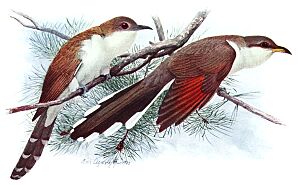
How Scientists Classify Black-billed Cuckoos
The black-billed cuckoo was first placed in the genus Cuculus. This group includes cuckoos from the Old World (Europe, Asia, Africa) that always lay eggs in other birds' nests.
Later, after more genetic testing, the black-billed cuckoo was moved to the genus Coccyzus. This group has nine species of New World cuckoos. The black-billed and yellow-billed cuckoos are the only two that fly to North America. The other seven live permanently in Central or South America. Even though these two cuckoos live in the same areas, they are not closely related. This suggests they came to North America at different times.
Protecting Black-billed Cuckoos
The black-billed cuckoo is listed as "Least Concern" on the IUCN red list. This means it's not currently in great danger. However, its population is still going down. It faces many of the same problems as other North American songbirds.
Pesticides are a big problem because these chemicals reduce the insects that cuckoos eat. Other threats include the loss of habitat, especially in their tropical winter homes. Growing cities also cause problems. Like other migratory birds, cuckoos often hit large buildings during their long flights, which can kill them.



